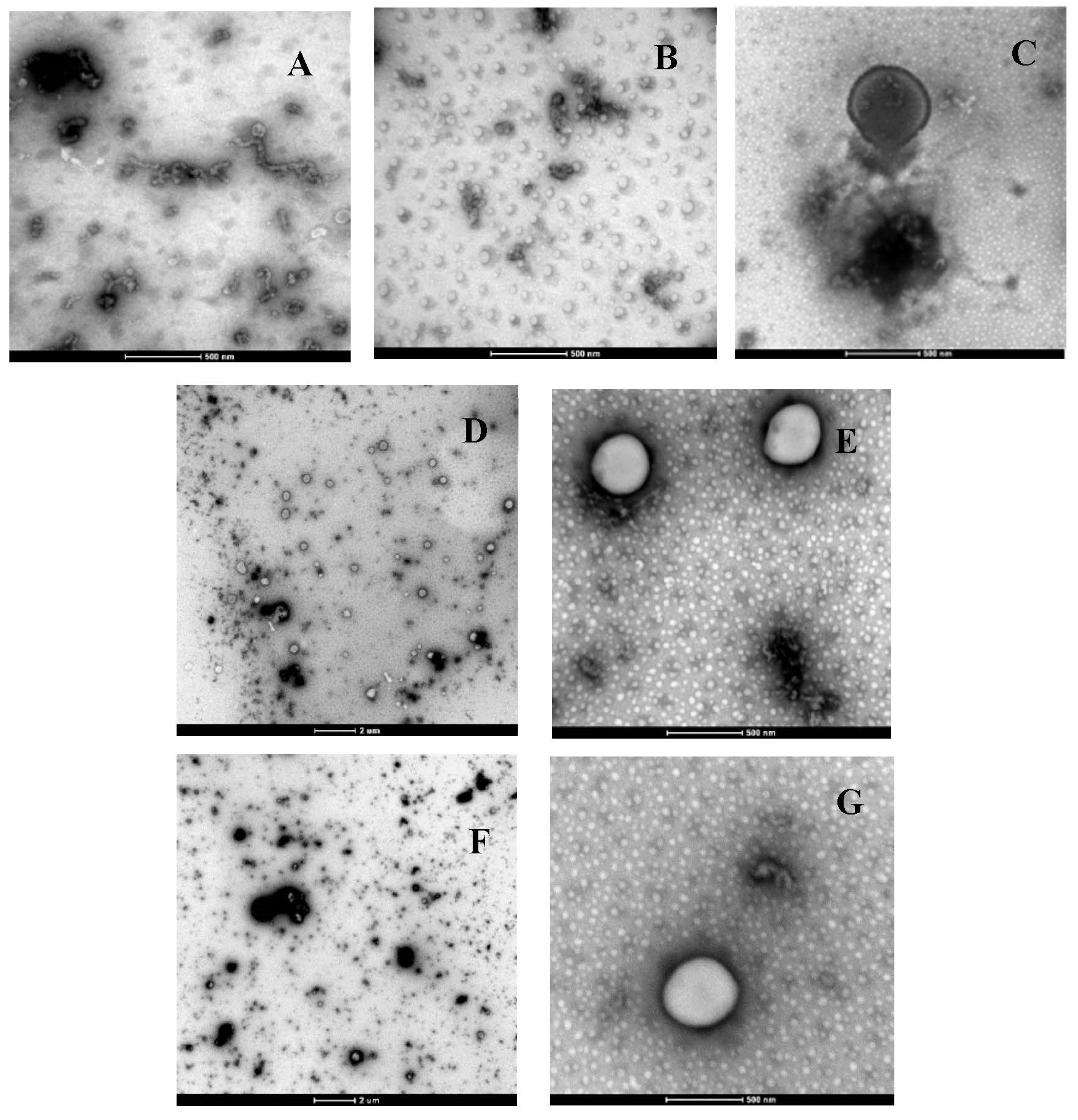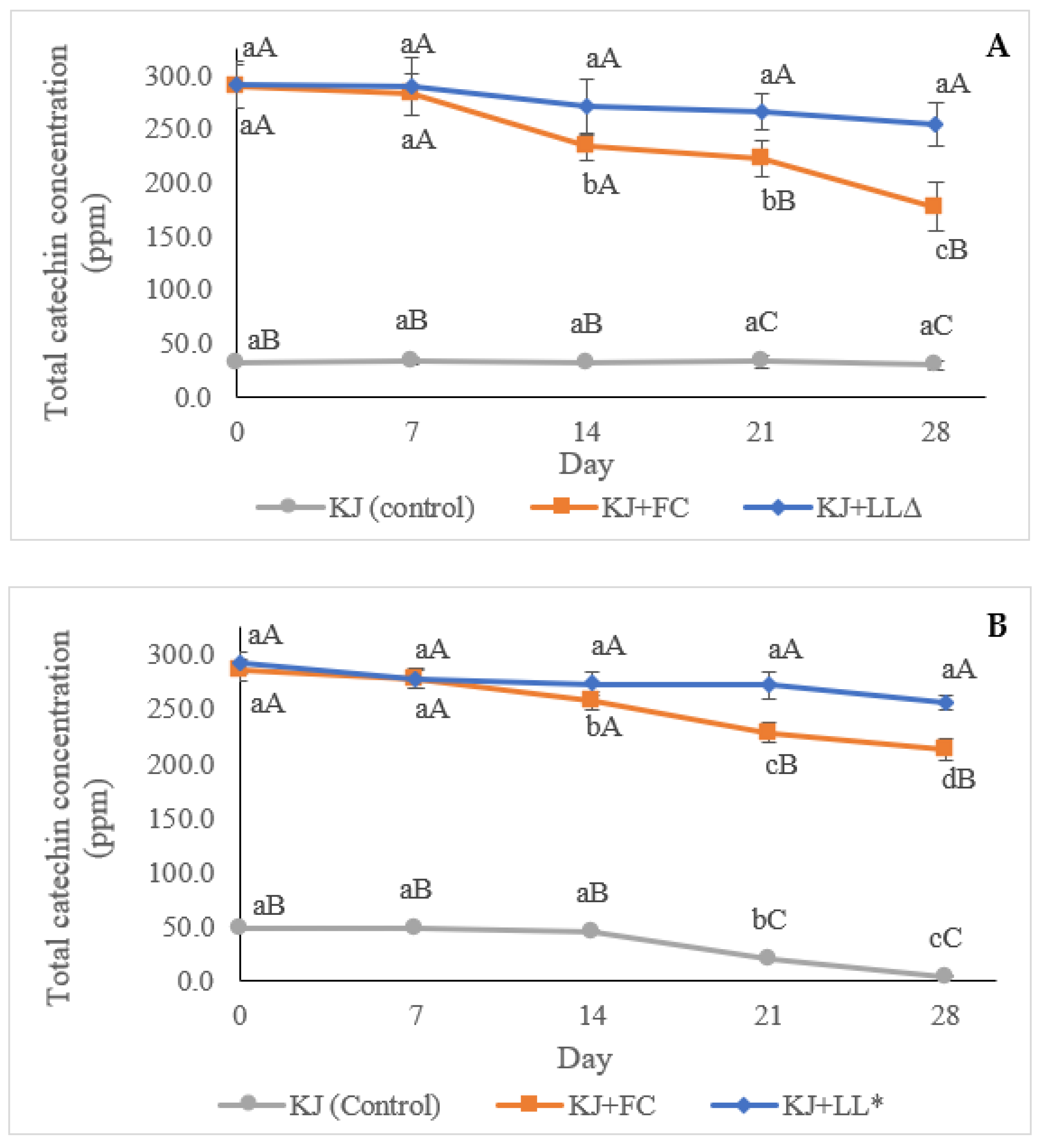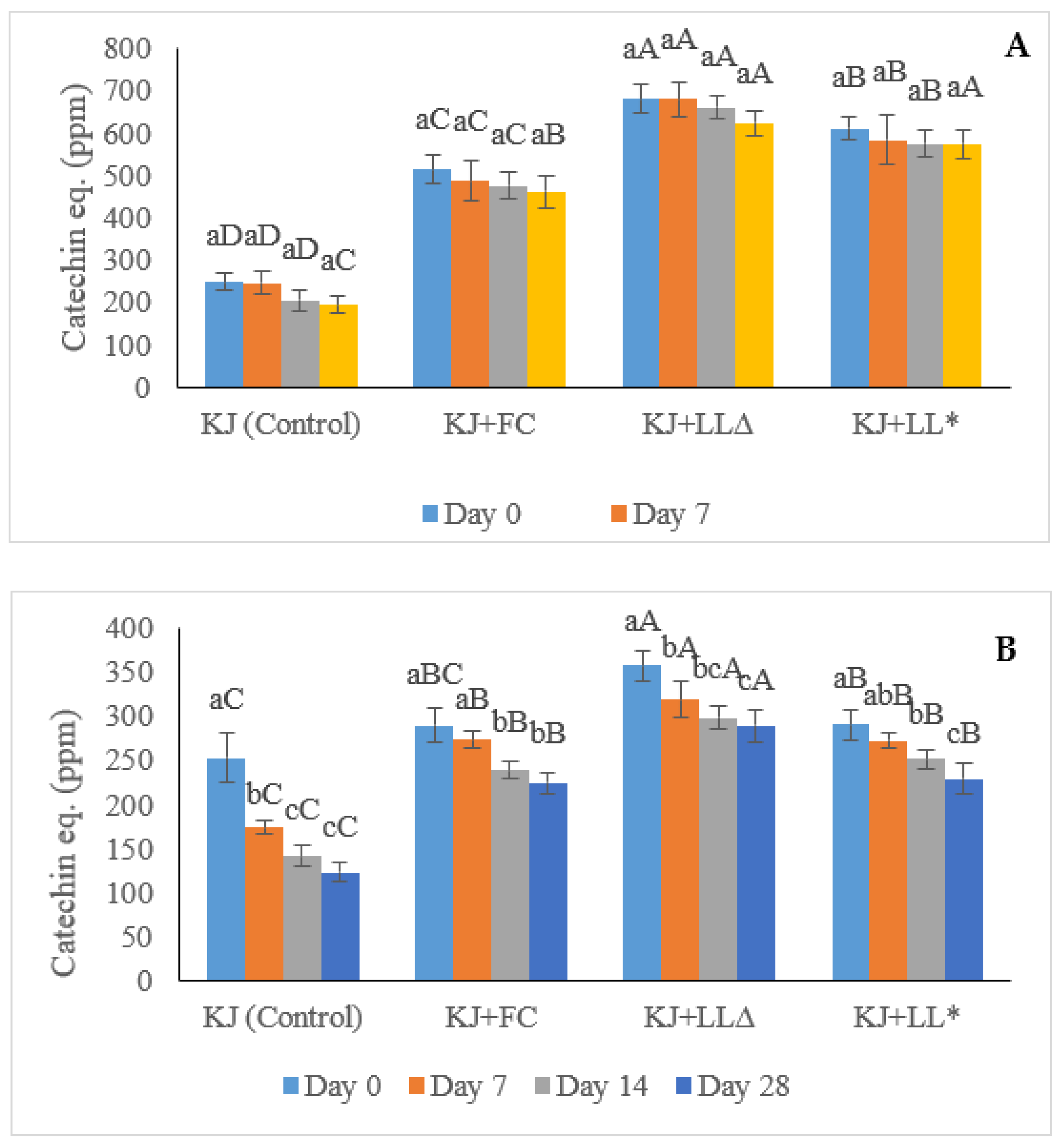Delivery of Catechins from Green Tea Waste in Single- and Double-Layer Liposomes via Their Incorporation into a Functional Green Kiwifruit Juice
Abstract
1. Introduction
2. Results
2.1. The Behaviour of the Single-Layer Liposomes (SLLs) in Green Kiwifruit Juice and the Effect on Its Properties
2.1.1. Encapsulation Efficiency (EE) and Loading Capacity (LC)
2.1.2. Particle Size and Zeta Potential
2.1.3. Morphology
2.1.4. Concentration of Catechins Determined by HPLC Analysis
2.1.5. Total Antioxidant Activity (TAA)
2.1.6. Total Phenolic Content (TPC)
2.2. The Behaviour of the Double-Layer Liposomes (DLLs) in Green Kiwifruit Juice
2.2.1. Particle Size and Zeta Potential Changes
2.2.2. Morphology and Microstructure
2.2.3. Total Phenolic Content (TPC) and Total Antioxidant Activity (TAA)
3. Materials and Methods
3.1. Green Tea Waste, Kiwifruit, Reagents, and Chemicals
3.2. Preparation of Liposomes
3.2.1. Encapsulation Efficiency
3.2.2. Loading Capacity
3.3. Manufacture of Green Kiwifruit Juice and the Incorporation of the Encapsulated Catechins
3.4. The Behaviour of the Encapsulated GTWE in Green Kiwifruit Juice and the Effect on Its Properties
3.4.1. Particle Size and Zeta Potential Measurements
3.4.2. Morphology Characterisation
3.4.3. HPLC Analysis
3.4.4. Total Phenolic Content
3.4.5. Total Antioxidant Activity (TAA) Determination
3.5. Statistical Analysis
4. Conclusions
Author Contributions
Funding
Institutional Review Board Statement
Informed Consent Statement
Data Availability Statement
Acknowledgments
Conflicts of Interest
References
- Ho, C.T.; Lin, J.K.; Shahadi, F. Tea and Tea Products: Chemistry and Health-Promoting Properties; Taylor & Francis: New York, NY, USA, 2009. [Google Scholar]
- Zhen, Y.S.; Chen, Z.M.; Cheng, S.J.; Chen, M.L. Tea: Bioactivity and Therapeutic Potential; Taylor & Francis: New York, NY, USA, 2002. [Google Scholar]
- Rashidinejad, A.; Birch, E.J.; Sun-Waterhouse, D.; Everett, D.W. Delivery of green tea catechin and epigallocatechin gallate in liposomes incorporated into low-fat hard cheese. Food Chem. 2014, 156, 176–183. [Google Scholar] [CrossRef]
- Wang, J.; Li, H.; Chen, Z.; Liu, W.; Chen, H. Characterization and storage properties of a new microencapsulation of tea polyphenols. Ind. Crops Prod. 2016, 89, 152–156. [Google Scholar] [CrossRef]
- Wang, L.; Gong, L.H.; Chen, C.-J.; Han, H.B.; Li, H.H. Column-chromatographic extraction and separation of polyphenols, caffeine and theanine from green tea. Food Chem. 2012, 131, 1539–1545. [Google Scholar] [CrossRef]
- Sui, W.; Xiao, Y.; Liu, R.; Wu, T.; Zhang, M. Steam explosion modification on tea waste to enhance bioactive compounds’ extractability and antioxidant capacity of extracts. J. Food Eng. 2019, 261, 51–59. [Google Scholar] [CrossRef]
- Choung, M.G.; Hwang, Y.S.; Lee, M.S.; Lee, J.; Kang, S.T.; Jun, T.H. Comparison of extraction and isolation efficiency of catechins and caffeine from green tea leaves using different solvent systems. Int. J. Food Sci. Technol. 2014, 49, 1572–1578. [Google Scholar] [CrossRef]
- Xing, L.; Zhang, H.; Qi, R.; Tsao, R.; Mine, Y. Recent Advances in the Understanding of the Health Benefits and Molecular Mechanisms Associated with Green Tea Polyphenols. J. Agric. Food Chem. 2019, 67, 1029–1043. [Google Scholar] [CrossRef]
- Gupta, S.; Hastak, K.; Afaq, F.; Ahmad, N.; Mukhtar, H. Essential role of caspases in epigallocatechin-3-gallate-mediated inhibition of nuclear factor kappaB and induction of apoptosis. Oncogene 2004, 23, 2507–2522. [Google Scholar] [CrossRef]
- Singh, B.N.; Shankar, S.; Srivastava, R.K. Green tea catechin, epigallocatechin-3-gallate (EGCG): Mechanisms, perspectives and clinical applications. Biochem. Pharmacol. 2011, 82, 1807–1821. [Google Scholar] [CrossRef]
- Madene, A.; Jacquot, M.; Scher, J.; Desobry, S. Flavour encapsulation and controlled release—A review. Int. J. Food Sci. Technol. 2006, 41, 1–21. [Google Scholar] [CrossRef]
- Rashidinejad, A.; Birch, E.J.; Everett, D.W. A novel functional full-fat hard cheese containing liposomal nanoencapsulated green tea catechins: Manufacture and recovery following simulated digestion. Food Funct. 2016, 7, 3283–3294. [Google Scholar] [CrossRef]
- Chen, W.; Zou, M.; Ma, X.; Lv, R.; Ding, T.; Liu, D. Co-Encapsulation of EGCG and Quercetin in Liposomes for Optimum Antioxidant Activity. J. Food Sci. 2018, 84, 111–120. [Google Scholar] [CrossRef]
- Richardson, D.P.; Ansell, J.; Drummond, L.N. The nutritional and health attributes of kiwifruit: A review. Eur. J. Nutr. 2018, 57, 2659–2676. [Google Scholar] [CrossRef]
- Drummond, L. The composition and nutritional value of kiwifruit. Adv. Food Nutr. Res. 2013, 68, 33–57. [Google Scholar] [PubMed]
- Ma, T.; Lan, T.; Ju, Y.; Cheng, G.; Que, Z.; Geng, T.; Fang, Y.; Sun, X. Comparison of the nutritional properties and biological activities of kiwifruit (Actinidia) and their different forms of products: Towards making kiwifruit more nutritious and functional. Food Funct. 2019, 10, 1317–1329. [Google Scholar] [CrossRef]
- Zou, L.Q.; Peng, S.F.; Liu, W.; Gan, L.; Liu, W.L.; Liang, R.H.; Liu, C.M.; Niu, J.; Cao, Y.L.; Liu, Z.; et al. Improved in vitro digestion stability of (−)-epigallocatechin gallate through nanoliposome encapsulation. Food Res. Int. 2014, 64, 492–499. [Google Scholar] [CrossRef]
- Ersus, S.; Yurdagel, U. Microencapsulation of anthocyanin pigments of black carrot (Daucus carota L.) by spray drier. J. Food Eng. 2007, 80, 805–812. [Google Scholar] [CrossRef]
- Ahmad, N.; Ahmad, R.; Naqvi, A.A.; Alam, M.A.; Ashafaq, M.; Samim, M.; Iqbal, Z.; Ahmad, F.J. Rutin-encapsulated chitosan nanoparticles targeted to the brain in the treatment of Cerebral Ischemia. Int. J. Biol. Macromol. 2016, 91, 640–655. [Google Scholar] [CrossRef]
- Rashidinejad, A.; Loveday, S.M.; Jameson, G.B.; Hindmarsh, J.P.; Singh, H. Rutin-casein co-precipitates as potential delivery vehicles for flavonoid rutin. Food Hydrocoll. 2019, 96, 451–462. [Google Scholar] [CrossRef]
- Igual, M.; Contreras, C.; Camacho, M.M.; Martínez, N.N. Effect of Thermal Treatment and Storage Conditions on the Physical and Sensory Properties of Grapefruit Juice. Food Bioprocess Technol. 2013, 7, 191–203. [Google Scholar] [CrossRef]
- Pelloux, J.; Rusterucci, C.; Mellerowicz, E.J. New insights into pectin methylesterase structure and function. Trends Plant Sci. 2007, 12, 267–277. [Google Scholar] [CrossRef] [PubMed]
- Marsanasco, M.; Márquez, A.L.; Wagner, J.R.; del, V.; Alonso, S.; Chiaramoni, N.S. Liposomes as vehicles for vitamins E and C: An alternative to fortify orange juice and offer vitamin C protection after heat treatment. Food Res. Int. 2011, 44, 3039–3046. [Google Scholar] [CrossRef]
- Sun-Waterhouse, D.; Bekkour, K.; Wadhwa, S.S.; Waterhouse, G.I.N. Rheological and Chemical Characterization of Smoothie Beverages Containing High Concentrations of Fibre and Polyphenols from Apple. Food Bioprocess Technol. 2013, 7, 409–423. [Google Scholar] [CrossRef]
- Zhu, D.; Shen, Y.; Wei, L.; Xu, L.; Cao, X.; Liu, H.; Li, J. Effect of particle size on the stability and flavor of cloudy apple juice. Food Chem. 2020, 328, 126967. [Google Scholar] [CrossRef]
- Sims, I.M.; Monro, J.A. Fiber: Composition, structures, and functional properties. Adv. Food Nutr. Res. 2013, 68, 81–99. [Google Scholar] [PubMed]
- Sorrivas, V.; Genovese, D.; Lozano, J. Effect of pectinolytic and amylolytic enzymes on apple juice turbidity. J. Food Process. Preserv. 2006, 30, 118–133. [Google Scholar] [CrossRef]
- Tembo, D.T.; Holmes, M.J.; Marshall, L.J. Effect of thermal treatment and storage on bioactive compounds, organic acids and antioxidant activity of baobab fruit (Adansonia digitata) pulp from Malawi. J. Food Compos. Anal. 2017, 58, 40–51. [Google Scholar] [CrossRef]
- Saura, C.F.; Díaz, R.M.E. Polyphenols associated with dietary fibre in wine. Food Res. Int. 2007, 40, 613–619. [Google Scholar] [CrossRef]
- Xu, J.Z.; Yeung, S.Y.V.; Chang, Q.; Huang, Y.; Chen, Z.Y. Comparison of antioxidant activity and bioavailability of tea epicatechins with their epimers. Br. J. Nutr. 2004, 91, 873–881. [Google Scholar]
- Igual, M.; García, M.E.; Camacho, M.M.; Martínez, N.N. Effect of thermal treatment and storage on the stability of organic acids and the functional value of grapefruit juice. Food Chem. 2010, 118, 291–299. [Google Scholar] [CrossRef]
- Feng, S.; Sun, Y.; Wang, P.; Sun, P.; Ritzoulis, C.; Shao, P. Co-encapsulation of resveratrol and epigallocatechin gallate in low methoxyl pectin-coated liposomes with great stability in orange juice. Int. J. Food Sci. Technol. 2019, 55, 1872–1880. [Google Scholar] [CrossRef]
- Kim, J.M.; Kang, J.Y.; Park, S.K.; Han, H.J.; Lee, K.Y.; Kim, A.N.; Kim, J.C.; Choi, S.G.; Heo, H.J. Effect of storage temperature on the antioxidant activity and catechins stability of Matcha (Camellia sinensis). Food Sci. Biotechnol. 2020, 29, 1261–1271. [Google Scholar] [CrossRef] [PubMed]
- Rashidinejad, A.; Birch, E.J.; Sun-Waterhouse, D.; Everett, D.W. Effects of catechin on the phenolic content and antioxidant properties of low-fat cheese. Int. J. Food Sci. Technol. 2013, 48, 2448–2455. [Google Scholar] [CrossRef]
- Dube, A.; Ng, K.; Nicolazzo, J.A.; Larson, I. Effective use of reducing agents and nanoparticle encapsulation in stabilizing catechins in alkaline solution. Food Chem. 2010, 122, 662–667. [Google Scholar] [CrossRef]
- Toro-Uribe, S.; López-Giraldo, L.J.; Alvarez-Rivera, G.; Ibáñez, E.; Herrero, M. Insight of Stability of Procyanidins in Free and Liposomal Form under an in Vitro Digestion Model: Study of Bioaccessibility, Kinetic Release Profile, Degradation, and Antioxidant Activity. J. Agric. Food Chem. 2019, 67, 1990–2003. [Google Scholar] [CrossRef]
- Saucier, C.T.; Waterhouse, A.L. Synergetic activity of catechin and other antioxidants. J. Agric. Food Chem. 1999, 47, 4491–4494. [Google Scholar] [CrossRef]
- Zhao, D.; Shah, N.P. Antiradical and tea polyphenol-stabilizing ability of functional fermented soymilk–tea beverage. Food Chem. 2014, 158, 262–269. [Google Scholar] [CrossRef]
- Sapei, L.; Hwa, L. Study on the Kinetics of Vitamin C Degradation in Fresh Strawberry Juices. Procedia Chem. 2014, 9, 62–68. [Google Scholar] [CrossRef]
- Klimczak, I.; Małecka, M.; Szlachta, M.; Gliszczyńska-Świgło, A. Effect of storage on the content of polyphenols, vitamin C and the antioxidant activity of orange juices. J. Food Compos. Anal. 2007, 20, 313–322. [Google Scholar] [CrossRef]
- Piljac-Žegarac, J.; Valek, L.; Martinez, S.; Belščak, A. Fluctuations in the phenolic content and antioxidant capacity of dark fruit juices in refrigerated storage. Food Chem. 2009, 113, 394–400. [Google Scholar] [CrossRef]
- Wicker, L.; Ackerley, J.; Corredig, M. Clarification of juice by thermolabile Valencia pectinmethylesterase is accelerated by cations. J. Agric. Food Chem. 2002, 50, 4091–4095. [Google Scholar] [CrossRef]
- Zhou, F.; Xu, T.; Zhao, Y.; Song, H.; Zhang, L.; Wu, X.; Lu, B. Chitosan-coated liposomes as delivery systems for improving the stability and oral bioavailability of acteoside. Food Hydrocoll. 2018, 83, 17–24. [Google Scholar] [CrossRef]
- Mady, M.M.; Darwish, M.M.; Khalil, S.; Khalil, W.M. Biophysical studies on chitosan-coated liposomes. Eur. Biophys. J. 2009, 38, 1127–1133. [Google Scholar] [CrossRef] [PubMed]
- Liang, T.; Jiao, S.; Jing, P. Molecular interaction between pectin and catechin/procyanidin in simulative juice model: Insights from spectroscopic, morphology, and antioxidant activity. J. Food Sci. 2021, 86, 2445–2456. [Google Scholar] [CrossRef] [PubMed]
- Laye, C.; McClements, D.J.; Weiss, J. Formation of biopolymer-coated liposomes by electrostatic deposition of chitosan. J. Food Sci. 2008, 73, N7–N15. [Google Scholar] [CrossRef] [PubMed]
- Guo, J.; Yuan, Y.; Dou, P.; Yue, T. Multivariate statistical analysis of the polyphenolic constituents in kiwifruit juices to trace fruit varieties and geographical origins. Food Chem. 2017, 232, 552–559. [Google Scholar] [CrossRef] [PubMed]
- Afkhami, R.; Goli, M.; Keramat, J. Functional orange juice enriched with encapsulated polyphenolic extract of lime waste and hesperidin. Int. J. Food Sci. Technol. 2018, 53, 634–643. [Google Scholar] [CrossRef]
- Ruozi, B.; Belletti, D.; Tombesi, A.; Tosi, G.; Bondioli, L.; Forni, F.; Vandelli, M.A. AFM, ESEM, TEM, and CLSM in liposomal characterization: A comparative study. Int. J. Nanomed. 2011, 6, 557–563. [Google Scholar] [CrossRef]
- Wang, H.; Provan, G.J.; Helliwell, K. HPLC determination of catechins in tea leaves and tea extracts using relative response factors. Food Chem. 2003, 81, 307–312. [Google Scholar] [CrossRef]
- Du, G.; Li, M.; Ma, F.; Liang, D. Antioxidant capacity and the relationship with polyphenol and Vitamin C in Actinidia fruits. Food Chem. 2009, 113, 557–562. [Google Scholar] [CrossRef]
- Kara, Ş.; Erçelebi, E.A. Thermal degradation kinetics of anthocyanins and visual colour of Urmu mulberry (Morus nigra L.). J. Food Eng. 2013, 116, 541–547. [Google Scholar] [CrossRef]
- Chen, Z.; Bertin, R.; Froldi, G. EC50 estimation of antioxidant activity in DPPH. assay using several statistical programs. Food Chem. 2013, 138, 414–420. [Google Scholar] [CrossRef] [PubMed]





| Analytical Methods/Storage Period | Day 0 | Day 7 | Day 14 | Day 28 |
|---|---|---|---|---|
| Particle size (D [4, 3]-Volume weighted mean (µm)) | ||||
| Kiwifruit juice (control) | 2.85 ± 0.04 aB * | 2.90 ± 0.05 aB | 2.88 ± 0.04 aB | 2.91 ± 0.02 aB |
| Kiwifruit juice + DLLs | 3.23 ± 0.07 bA | 3.34 ± 0.08 bA | 3.27 ± 0.11 bA | 22.62 ± 1.71 aA |
| Zeta potential (mV) | ||||
| Kiwifruit juice (control) | −8.80 ± 0.46 aA | −8.30 ± 0.55 aA | −8.45 ± 0.46 aA | −9.06 ± 0.79 aA |
| Kiwifruit juice + DLLs | −8.98 ± 0.46 aA | −8.77 ± 0.49 aA | −8.11 ± 0.52 aA | −8.88 ± 0.66 aA |
| Total phenolic content (catechin equivalent (ppm)) | ||||
| Kiwifruit juice (control) | 253.30 ± 27.40 aB | 174.09 ± 7.83 bB | 141.16 ± 11.94 cB | 122.29 ± 10.90 cB |
| Kiwifruit juice + free GTW catechins | 290.37 ± 19.11 aB | 273.59 ± 9.28 aA | 238.90 ± 10.06 bA | 224.24 ± 11.83 bA |
| Kiwifruit juice + DLLs | 359.86 ± 30.65 aA | 263.99 ± 9.39 bA | 226.44 ± 8.07 cA | 226.12 ± 11.36 cA |
| Total antioxidant activity (Catechin equivalent (ppm)) | ||||
| Kiwifruit juice (control) | 248.64 ± 20.28 aC | 245.90 ± 26.90 aB | 205.07 ± 23.46 aB | 195.30 ± 18.85 aB |
| Kiwifruit juice + free GTW catechins | 514.90 ± 34.60 aB | 487.30 ± 46.70 aA | 476.20 ± 30.80 aA | 461.50 ± 37.90 aA |
| Kiwifruit juice + DLLs | 555.08 ± 26.58 aA | 488.21 ± 11.56 bA | 480.24 ± 10.27 bA | 472.67 ± 18.35 bA |
Disclaimer/Publisher’s Note: The statements, opinions and data contained in all publications are solely those of the individual author(s) and contributor(s) and not of MDPI and/or the editor(s). MDPI and/or the editor(s) disclaim responsibility for any injury to people or property resulting from any ideas, methods, instructions or products referred to in the content. |
© 2023 by the authors. Licensee MDPI, Basel, Switzerland. This article is an open access article distributed under the terms and conditions of the Creative Commons Attribution (CC BY) license (https://creativecommons.org/licenses/by/4.0/).
Share and Cite
Athirojthanakij, W.; Rashidinejad, A. Delivery of Catechins from Green Tea Waste in Single- and Double-Layer Liposomes via Their Incorporation into a Functional Green Kiwifruit Juice. Molecules 2023, 28, 575. https://doi.org/10.3390/molecules28020575
Athirojthanakij W, Rashidinejad A. Delivery of Catechins from Green Tea Waste in Single- and Double-Layer Liposomes via Their Incorporation into a Functional Green Kiwifruit Juice. Molecules. 2023; 28(2):575. https://doi.org/10.3390/molecules28020575
Chicago/Turabian StyleAthirojthanakij, Weerawich, and Ali Rashidinejad. 2023. "Delivery of Catechins from Green Tea Waste in Single- and Double-Layer Liposomes via Their Incorporation into a Functional Green Kiwifruit Juice" Molecules 28, no. 2: 575. https://doi.org/10.3390/molecules28020575
APA StyleAthirojthanakij, W., & Rashidinejad, A. (2023). Delivery of Catechins from Green Tea Waste in Single- and Double-Layer Liposomes via Their Incorporation into a Functional Green Kiwifruit Juice. Molecules, 28(2), 575. https://doi.org/10.3390/molecules28020575





